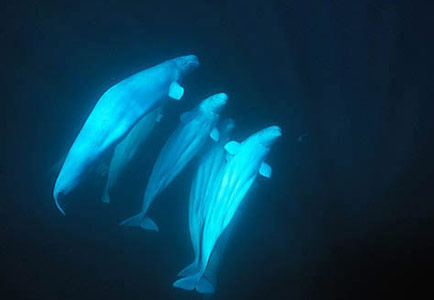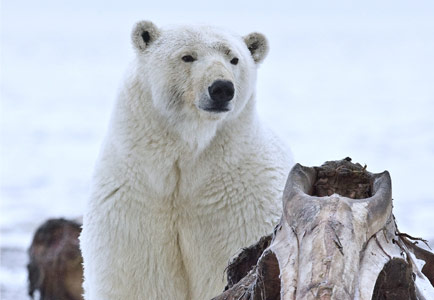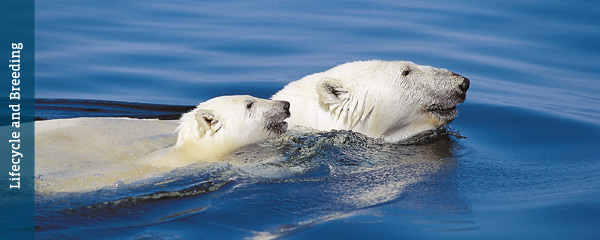Polar bears are the largest land carnivores in the world. They are also the most carnivorous member of the Ursidae family; meaning that they eat primarily meat, and very rarely eat vegetation. Polar bears have adapted to consume a diet that is extremely high in fat. So high in fact, that the same diet would kill most other animals.
A polar bear’s activity level peaks in the morning hours, and only declines as the day progresses. Adult females with cubs spend 19% of their time in the spring hunting, and 38% in the summertime. Comparatively, for adult males, it’s 25% in the spring and 40% in the summer.



Food sources
- Seal – The largest part of a polar bear’s diet is seal. Ringed and bearded seals are the most common seal type across the entire Arctic, with hooded and harp seals inhabiting areas from the east coast of Canada to the border of western Russia.Adult polar bears consume only the calorie rich skin and blubber, while younger growing bears will also eat the meat, which is high in protein. Even at their smallest, adult male bearded seals outweigh adult female polar bears, and are usually only prey for adult male polar bears.
Polar bears use three methods for hunting seal:
- Still hunting – Still hunting is the polar bear’s most used hunting method. A bear will locate a seal’s breathing hole, sometimes from up to 1 kilometre away, with its exceptional sense of smell. It will then crouch silently next to the hole, lying in wait for several hours if necessary. Once a seal breaches the water within the ice hole, the polar bear smells its breath, and will reach into the hole with its paw and drag the seal onto the ice. The polar bear bites the skull of the seal, crushing its skull, killing it.
- Stalking – Polar bears also hunt seals that are resting on the ice; a bear can smell a seal on the open ice from up to 32 kilometres away. Once the bear selects its target, it will walk to within 300 feet, then crouch. If the seal hasn’t noticed, the bear will then creep slowly to within 40 feet of it and then rush forward suddenly in an attack.
- Raiding – Seal pups left unattended in the den are extremely vulnerable and easy prey for the polar bear.
- Beluga whales, narwhals, and dolphins – These smaller marine mammals are sometimes hunted in a similar manner to the seal. Whales are generally able to avoid polar bears, though they sometimes become trapped in polynya, which are areas of open water surrounded by ice. Dolphins trapped in the ice were observed being hunted by polar bears in Svalbard, Norway.
- Walruses – Polar bears rarely attack walruses because of their sheer size alone, the average body mass of an adult walrus is 600 to 1500 pounds. Walruses also have long ivory tusks that could injure a polar bear in a fight, so they stick to targeting the young, sick, or elderly.
- Fish and seafood – Arctic char and the fourhorn sculpin are two types of fish that the polar bear will typically go fishing for. Bears in the Hudson Bay and James Bay regions of Canada also dive for blue mussels and green sea urchins.
- Aquatic birds – Polar bears swim underwater to catch sea ducks, common eider, long-tailed duck, or dovekie. If they are able to climb up to the height of a nest, they will also eat the nesting parent and their eggs.
- Land animals – Hunting animals on land can be tricky for polar bears. They appear to use vegetative cover and wind direction to bring them as close to their prey as possible attacking. Polar bears can produce bursts of speed over short distances, but they overheat easily, and can generally be outrun. The land animal menu includes reindeer, muskox, barren-ground caribou, and willow ptarmigan.
- Vegetation – When no other food is available polar bears will eat vegetation such as berries, grass, and kelp. Hudson Bay polar bears exercise more dietary flexibility because they must go the whole summer without sea ice to hunt on. In that region the bears, along with aquatic birds, supplement their diet with seaweed, willows, black crowberry, moss, and grass.
- Other – Polar bears are also not entirely opposed to eating beach-cast marine mammals, rodents, other polar bears, or garbage.







